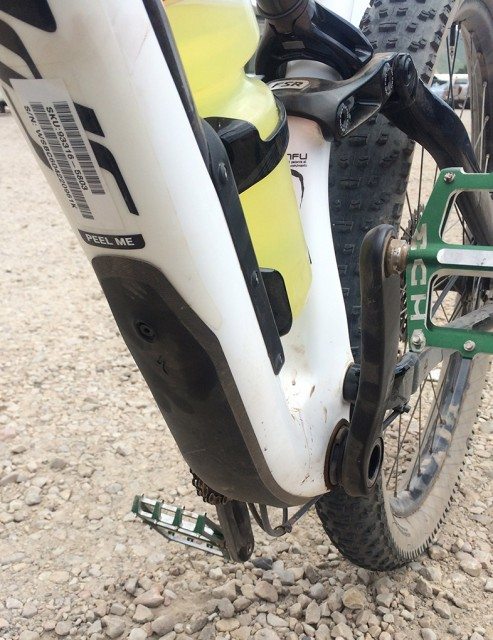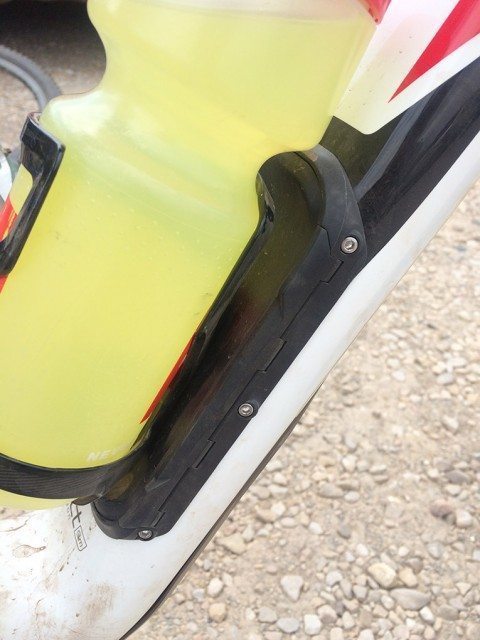Frame Details
Specialized bolts an aluminum rear end to a carbon front triangle for all but their least expensive Stumpjumper FSR Comp (which features an aluminum front triangle). The same front triangle is shared between 29” wheeled Camber and Stumpjumper models, as well as the 27.5 Plus Stumpjumper. This means that all Specialized had to do to create the 27.5 Plus Stumpjumper was fabricate a new wide rear end.
According to Specialized, the combination of an aluminum rear end and carbon front “blends stiffness with light weight to form the pinnacle of efficiency” – so you’ve got that going for you.
But really, by welding up an aluminum 27.5 Plus rear end, Specialized is able to test the waters for the 27.5 plus size without opening carbon molds ($$$$). Maybe if the wheel size is a big success, we will see a carbon rear end added at a later date? Don’t hold your breath though–the other Stumpjumper models with more established wheel sizes also have aluminum rear ends.
The front and rear ends are bolted together with pivots utilizing sealed cartridge bearings. Nothing unusual there.
The headset has a Campy-style integrated upper bearing, and standard integrated lower bearing. This relies on the carbon interior surface of the headtube to interface directly with the bearing. It looks sleek and keeps the front end low, because the bottom bearing doesn’t need to stick out of the headtube. But I see it as a little less of a sure thing than an external cup headset since the bearing is interfacing with carbon instead of a machined aluminum cup.
The bottom bracket is a press fit unit – SRAM PF30, to be specific. Many people have bemoaned the use of these, but they do make things simple for the manufacturer since they don’t have to put an aluminum threaded insert in a carbon frame. Instead, they can just make a straight hole through the frame. It’s much easier to manufacture, and it negates the chance of an insert separating from the carbon frame. Carbon doesn’t much like to bond to anything.
All the cables and hoses are routed internally. It looks slick, but makes it a pain to swap brakes, and the bundle of cables and hoses pops out below the bottom bracket, exposing them to rock strikes. The downtube itself is protected by a plastic guard, but that doesn’t do anything to protect the cables and hoses.

Both the front and rear of the bike use the new Boost spacing standard. On a 29er or 27.5 Plus bike, I’m a proponent of the new spacing standard. The introduction of new standards is always a pain, but the added stiffness from the wider spacing is especially welcome with the big wheels.
SWAT Storage
Specialized has put a lot of effort into developing first apparel, and now bikes that facilitate riding without a pack. I’m into it. I never minded riding with a pack until I started riding without one last year. It is just more fun. I feel like I can move better on a bike, and my balance is improved without a load on my back shifting around.
The Stumpjumper features a SWAT storage chamber in the down tube (essentially a hatch in the downtube under the bottle cage), a bottle cage that can have a tool mounted to the back of it, and a mount for a tool hidden inside the front shock mount. I didn’t have a tool that would fit in either of those spots, but I definitely used the down tube storage.

The SWAT storage was actually kinda sweet and saved me once – I thought I’d forgotten a tube and pump, till I remembered that I had stashed one in the Stumpjumper’s frame. But the SWAT chamber cover does leak a little, so don’t count on keeping anything in it dry on a rainy day.
NEXT: Suspension Setup, On the Trail, Etc.

Sort of minor question…. the Specialized dropper lever is not compatible with a thomson? I’ve used one with mine for a year. Definitely a bit of a pull but works fine.
I know Thomson changed their setup at some point last year and flipped around how the cable is oriented. The post I have requires the swaged cable end to attach at the bottom of the post. The Specialized lever requires that the swaged end terminates at the lever. If you are determined, you could swage a second end onto the cable and make it work, but short of that it isn’t easily compatible.
Nevermind then. I have the older, non internal thomson dropper.
Great review. Love the depth. Every Specialized I’ve owned has been expensive — from pedal replacement costs due to their ridiculously low bottom brackets. No easy fix for taller guys, either.
OTOH, it’s much easier to add a volume reducer to a Fox shock to reduce bottoming than it is to remove a non-existent one due to excessive ramp up. I like S’s approach in this regard.
Thanks Tom. I agree that it is easier to add a reducer than remove a non-existent one. I hope to add one to this bike to try it out. I’m not sure whether or not I’ll be able to get enough ramp though. It is very deficient and the shock already has a stroke reducer in it so I’m not sure how much I’ll be able to fit in there in terms of spacers.